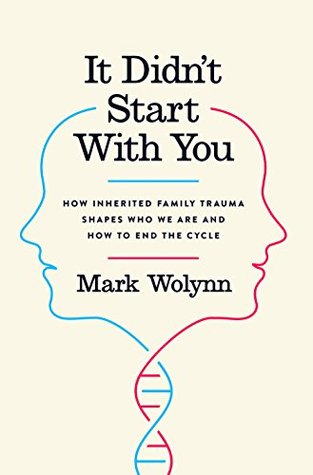More on this book
Community
Kindle Notes & Highlights
by
Mark Wolynn
Started reading
August 23, 2022
my personal language of fear.
when we try to resist feeling something painful, we often protract the very pain we’re trying to avoid.
Delia and 1 other person liked this
Traumatic reenactment, or “repetition compulsion,” as Freud called it, is an attempt of the unconscious to replay what’s unresolved, so we can “get it right.”
This unconscious drive to relive past events could be one of the mechanisms at work when families repeat unresolved traumas in future generations.
what remains unconscious does not dissolve but, rather, resurfaces in our lives
In other words, we’re likely to keep repeating our unconscious patterns until we bring them into the light of awareness.
importance of exploring at least three generations of family history in order to understand the mechanism behind patterns of trauma and suffering that repeat.
Sometimes pain submerges until it can find a pathway for expression or resolution.
When your grandmother was five months pregnant with your mother, the precursor cell of the egg you developed from was already present in your mother’s ovaries.
This means that before your mother was even born, your mother, your grandmother, and the
earliest traces of you were all in the same body—three generations sharing the sam...
This highlight has been truncated due to consecutive passage length restrictions.
The precursor cells of the sperm you developed from were present in your father when he was a fetus in his mother’s womb.
Your father’s sperm continued to multiply when he reached puberty, whereas your mother was born with her lifetime supply of eggs.
his sperm continues to be susceptible to traumatic imprints almost up until the point when you are conceived.
the environment, from as early as conception, begin to shape us emotionally, psychologically, and biologically, and this shaping continues throughout our lives.
our DNA can be affected by both negative and positive thoughts, beliefs, and emotions.
signals from the environment could operate through the cell membrane, controlling the behavior and physiology of the cell, which in turn could activate or silence a gene.
“The mother’s emotions, such as fear, anger, love, hope among others, can biochemically alter the genetic expression of her offspring.”5 During pregnancy, nutrients in the mother’s blood nourish the fetus through the wall of the placenta. With the nutrients, she also releases a host of hormones and information signals generated by the emotions she experiences.
our thoughts, inner images, and daily practices, such as visualization and meditation, can change the way our genes express, an idea we will examine in more detail in the next chapter.
A life completely devoid of trauma, as we’re learning, is highly unlikely. Traumas do not sleep, even with death, but, rather, continue to look for the fertile ground of resolution in the children of the
following generations. Fortunately, human beings are resilient and are capable of healing most types of trauma. This can happen at any time during our lives. We just need the right insights and tools.
open our constricted hearts, and regard our parents and other family members with the light of compassion.
What event had the power to interrupt the flow of love in your relationship?
Perhaps your mother carried a wound from her mother and was unable to give you what she didn’t get. Her parenting skills would be limited by what she did not receive from her parents.
The emotions, traits, and behaviors we reject in our parents will likely live on in us. It’s
When we reject our parents, we can’t see the ways in which we’re similar.
The behaviors become disowned in us and are often projected onto the people around us. Conversely, we can attract friends, romantic partners, or business associates who display the very behaviors we reject, allowing us myriad opportunities to recognize and heal the dynamic.
Visualize your mother as a young woman or a small child or even a small baby tightening against the waves of loss, trying to protect herself from the onslaught of pain.
Tell her in your heart, “Mom, I understand.” Even if you don’t fully understand, say the words again. “Mom, I understand.” Consider adding the words “Mom, I’ll try to take in your love just as it is, without judging it or expecting it to be different.”
What happens in your body when you tell her this? Is there any place in your body that lets go, opens, or feels softer?
Ninety-one percent of participants who stated that their relationship with their mother was tolerant or strained were diagnosed with a significant health issue (such as cancer, coronary artery disease, hypertension, etc.) in midlife, compared with 45 percent of participants—less than half—who reported that their relationship with their mothers was warm or close.
cancer rates correlated closely with the degree of distance a participant felt toward a parent.2


